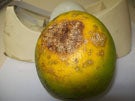It’s time to spray for Sweet Orange Scab in citrus
Published 12:00 am Saturday, March 17, 2012
If Sweet Orange Scab affected the citrus in your yard this past year, now is the time to spray the citrus trees to prevent the disease from injuring this year’s crop. The disease actually affects the growing fruit when it first begins to develop just after blossom set. Homeowners do not recognize the damage until the fruit is bigger, usually around August or September. This is because the damage on the fruit grows larger and becomes more apparent as the fruit grows. Although this disease is identified as the Sweet Orange Scab disease, this disease may also affect other varieties of citrus as well as Sweet Oranges. The symptoms include scarring, drying and hardened, pitted sections of the fruit, sometimes affecting almost half of the surface of the fruit. Some of the fruit even has lesions or scabs about the size of a nickel on the surface of the fruit. About 80-90 percent of the fruit on the trees may have been infected.
The SOS disease was first reported in Paraguay in 1882. On July 23, 2010, it was confirmed in the U.S. on residential citrus in Harris County, Texas. It was then confirmed on residential citrus in Orleans Parish on Aug. 10, 2010. Later, on Oct. 22, 2010, it was confirmed on citrus in Mississippi. On Dec. 22, 2010, a quarantine was established for SOS by the U.S. Department of Agriculture’s Animal and Plant Health Inspection Service. The quarantine was established to prevent the spread of SOS to other citrus growing states. Citrus produced in Texas, Louisiana and Mississippi cannot be transported outside of these states.
The SOS disease is spread by spores, which are dispersed by splashing water and wind driven rain. The spores are produced when scab lesions are wet for at least one to two hours, the humidity is very high and the temperatures are from 68-82 degrees Fahrenheit. The scab lesions develop on infected fruit, leaves and twigs and develop spores when the conditions are right; then the spores are spread by the splashing water and wind driven rain. The fruit is susceptible to the SOS disease when it is first developing, from petal fall (fruit set) until it is about two months old. At around two months of age or around marble size, the surface of the fruit hardens and the spores no longer affect the fruit.
It is important that you spray your trees with a copper fungicide from petal fall until the fruit is two months old. This should be done in three sprays – the first spray should be applied when the petals fall (fruit set), the second spray 3-4 weeks later and the third spray three to four weeks after the second spray. The removal of infected fruit, leaves and plant parts is also recommended to help control the disease. With proper spraying of a copper fungicide and with proper removal of plant parts the SOS disease can be controlled and possibly eliminated.
If you have further questions concerning the diseases of citrus and/or other questions about citrus, Publication 1234 – Louisiana Home Citrus Production contains all the information on home citrus production. The publication used to cost $5, but it is now free. The publication may be purchased on the LSU Ag Center’s website at lsuagcenter.com or you may visit your local Parish LSU Ag Center Office and get one free. You may also view on the LSU Ag center’s website Publication 3169 – Louisiana Plant Pathology Series – Disease Identification and Management – Scab Diseases of Citrus.
If you have any questions, you may contact David Pichon, LSU Ag Center county agent, by phone at 985-497-3261 or you may email him at dpichon@agcenter.lsu.edu. The LSU Ag Center is available to help you with your problems, and usually the help is free.
If you have any questions, please contact your local LSU Ag Center County Agent. You can contact David Pichon, County Agent-St. John Parish at 985-497-3261 or by email at dpichon@agctr.lsu.edu.






